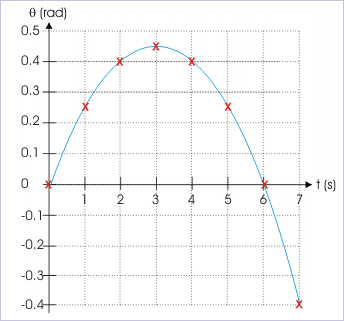| << Chapter < Page | Chapter >> Page > |
------------------------------------------------------------------------------------
Time wo t Angular displacement (θ)(s) (rad) (rad)
------------------------------------------------------------------------------------0 0.0 0.00
1 0.3 x 1 0.3 – 0.5 x 0.1 x 1 = 0.3 – 0.05 = 0.252 0.3 x 2 0.6 – 0.5 x 0.1 x 4 = 0.6 – 0.20 = 0.40
3 0.3 x 3 0.9 – 0.5 x 0.1 x 9 = 0.9 – 0.45 = 0.454 0.3 x 4 1.2 – 0.5 x 0.1 x 16 = 1.2 – 0.80 = 0.40
5 0.3 x 5 1.5 – 0.5 x 0.1 x 25 = 1.5 – 1.25 = 0.256 0.3 x 6 1.8 – 0.5 x 0.1 x 36 = 1.8 – 1.80 = 0.00
7 0.3 x 7 2.1 – 0.5 x 0.1 x 49 = 2.1 – 2.50 = -0.40------------------------------------------------------------------------------------
We see here that the particle moves in anti-clockwise direction for first 3 seconds as determined earlier and then turns back (clockwise) retracing the path till it reaches the initial position. Subsequently, the particle continues moving in the clockwise direction.
The angular displacement – time plot is as shown here :
Angular displacement – time plot

Problem : A particle at the periphery of a disk at a radial distance 10 m from the axis of rotation, uniformly accelerates for a period of 20 seconds. The speed of the particle in the meantime increases from 5 m/s to 20 m/s. Find the numbers of revolutions the particle completes around the axis.
Solution : We need to find angular displacement to know the numbers of revolutions made. Here,
To calculate angular displacement, we need to know angular acceleration. Here, we can calculate angular acceleration as in the earlier exercise as :
Now, using equation of motion, , we have :
The number of revolutions (nearest integer), n,
The angular velocity .vs. time plot of the motion of a rotating disk is shown in the figure. Then,
Velocity .vs. time plot

angular acceleration is constant.
angular acceleration is negative.
disk comes to a stop at a particular instant.
disk reverses direction during the motion.
The slope of the straight line is a negative constant. Therefore, options (a) and (b) are correct. The line crosses time axis, when angular velocity is zero. Thus option (c) is correct. The angular velocities have opposite sign across time axis. It means that the disk reverses its direction. Thus option (d) is correct.
Hence, options (a),(b),(c) and (d) are correct.
A point on a rotating disk, starting from rest, achieves an angular velocity of 40 rad/s at constant rate in 5 seconds. If the point is at a distance 0.1 meters from the center of the disk, then the distance covered (in meters) during the motion is :
We can find the distance covered, if we know the angular displacement. On the other hand, we can find angular displacement if we know the average angular speed as time is given.
We can consider this accelerated motion as uniform motion with average speed as calculated above. The angular displacement is :
The distance covered is :
A point on a rotating disk completes two revolutions starting from rest and achieves an angular velocity of 8 rad/s. If the angular velocity of the disk is increasing at a constant rate, the angular acceleration ( ) is :
We can use the equation of motion for constant acceleration. Here,
Looking at the data, it is easy to find that the following equation will serve the purpose,
Solving for "α" and putting values,
Hence, option (c) is correct.
A point on a rotating disk is accelerating at a constant rate 1 till it achieves an angular velocity of 10 rad/s. What is the angular displacement (radian) in last 2 seconds of the motion?
Here, final angular velocity, angular acceleration and time of motion are given. We can find the angular displacement using equation of motion for angular displacement that involves final angular velocity :
Putting values, we have :
Hence, option (a) is correct.

Notification Switch
Would you like to follow the 'Physics for k-12' conversation and receive update notifications?